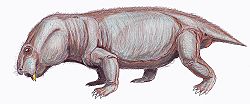| Oudenodon Temporal range: Late Permian | |
|---|---|
 | |
| O. baini skull at the Museum für Naturkunde, Berlin | |
| Scientific classification | |
| Domain: | Eukaryota |
| Kingdom: | Animalia |
| Phylum: | Chordata |
| Clade: | Synapsida |
| Clade: | Therapsida |
| Suborder: | † Anomodontia |
| Clade: | † Dicynodontia |
| Family: | † Oudenodontidae |
| Genus: | † Oudenodon Owen, 1860 |
| Species | |
| |
| Synonyms | |
Genus synonymy
Species synonymy
| |


Oudenodon is an extinct genus of dicynodont. It was common throughout southern Africa during the Late Permian. Several species of Oudenodon are known. [2] Both O. bainii, the type species, and O. grandis are known from South Africa. [3] [4] Specimens of O. luangwensis have been found from Zambia. [5] One species, O. sakamenensis, is the only Permian therapsid yet described from Madagascar. [6] It is the type genus of the family Oudenodontidae, which includes members such as Tropidostoma .





